| 1 | Central American jumping viper |
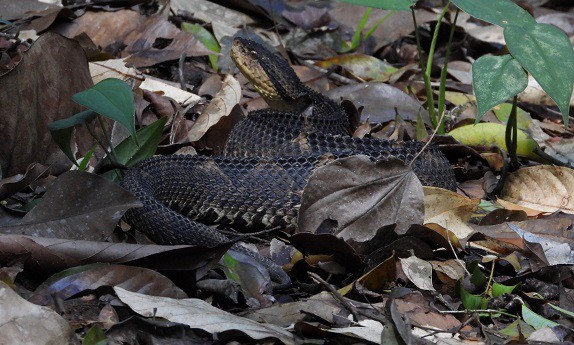
The Central American jumping viper cannot actually jump. They’re not the bunny rabbit of the snake kingdom, which hops after you for miles and miles until you wake up in your hotel bed the next day only to find it’s still coming. However, they do have exceptional camouflage, and a lazy nature, which combine to make them very easy to step on.
Central American jumping vipers live from extreme southern Mexico to western Panama. They like moist, dense forests, particularly at the base of trees, where they wait in dark hollows to pounce on mammal prey, when they’re confident that they’re in range. Metlapilcoatlus mexicanus measures just 50-70cm, versus 3 metres for a central American bushmaster. You truly need an eagle eye to spot them, as it’s very rare to find them in open grassland.
Mexican jumping vipers have caused few deaths. Their venom is believed to contain a mixture of anticoagulants and cytotoxins, with few neurotoxins. Their disguised nature could have deadly consequences if you place your ankle directly next to where they’re lurking. But it’s just as likely that you’ll instantly lift your leg up, and never realise how close you came to this secretive 60cm serpent. This species belongs to the same family as the Mexican jumping viper (Metlapilcoatlus nummifer).
| 2 | Copperhead |
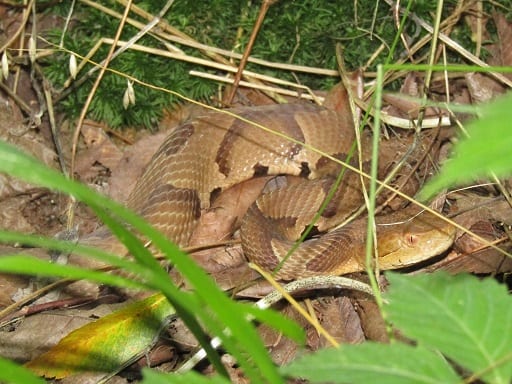
Copperheads are the main woodland lurker of the eastern US, blending completely into leaves with their signature orange-brown hourglasses. While rarely killing, they cause more snakebites annually than any species, with 1809 bites recorded in 2014 alone. Copperheads measure 60-120cm and are ambush snakes, which stay still before pouncing on passing rodents with a crushing lunge. They can wait for hours, before shifting a few metres to a new position.
Most US townsfolk know which woods copperheads are in, such is their reputation of fear. But even then, locals still make mistakes and step on them. Copperheads are the subject of many myths, such as a cucumber smell indicating their presence, or an overall murderous personality. In 2020, scientists decided to analyse its personality properly. They found that when scientists walked past, even inches away, the copperheads virtually never struck. In fact, many fled at high speeds into the undergrowth.
Scientists tied a boot to the end of a scientific instrument and pressed down on their body, to mimic a human stepping on them. They also tied a glove to a pair of tongs and picked them up. These methods sometimes provoked bites, whereas normally they were non-aggressive. US woodlands are like a natural minefield, not with explosions, but an explosive serpent pounce.
| 3 | Painted lancehead |
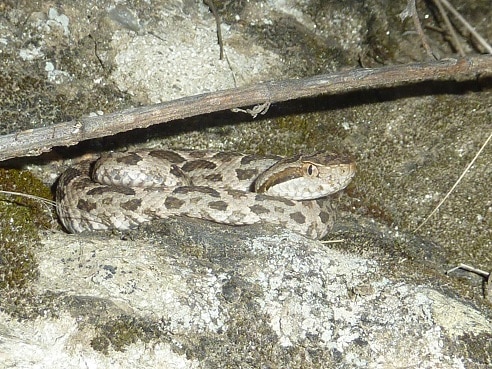
Many people dream of meeting a venomous snake at least once in their life. Many people would love the thrill of seeing a cold-blooded viper from a safe distance, knowing that it could fully wipe you out. But if you’re not careful, your first venomous snake encounter could be your last, beginning with you accidentally stepping on a painted lancehead.
This is Argentina’s main venomous snake, also occupying Paraguay and far southern Brazil. It measures 60-110cm and has one of the most haemorrhagic venoms of its Bothrops family, triggering copious spontaneous bleeding, while being slightly milder for swelling. Painted lanceheads eat a flexible diet, with mammals, reptiles and amphibians in equal share. Another characteristic is a love for grassy, brushy vegetation on the outskirts of woodland and grassland. It’s this preference for partial disguise which makes people step on them so much.
Farmers, dog-walkers and exploring teenagers have all met a painted lancehead after failing to spot their lurking place. When stepped on, painted lanceheads react angrily (not surprisingly). They deliver lunging bites to the legs, ankles and possibly torso. The best case scenario is that their fangs deflect off thick boots. Adding to the danger is the painted lancehead’s cryptic colour scheme, with beige-black tones and glowing trapezoid markings. Painted lanceheads are common in semi-modified places like villages and woodlands.
| 4 | Rubber boa |
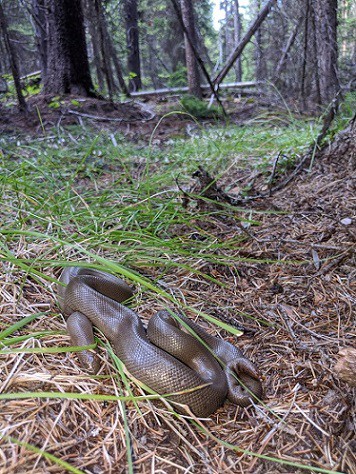
A classic slow and steady snake. Rubber boas inhabit Orgon and California, and can live for over 50 years. They barely move for days on end, resting on scenic grassy hilltops and woodland edges. Rubber boas are also relatively dull, with chocolatey brown scales which are smooth like a worm.
Rubber boas rarely rear up and scan the horizon inquisitively. Nor do they hiss when hikers draw to a close. The one part of the “get stepped on” recipe missing is living in urban areas. However, rubber boas do live near popular trails and hiking routes. They may be found near popular viewing points and picnic benches. They can also appear by the sides of trails in villages.
Rubber boas are completely harmless, and unlike an emerald tree boa, their front fangs are no threat. You can pick up a rubber boa with no worries. The biggest worry is hurting them. If your reactions are fast enough, you might be able to stop your shoe from descending with just millimetres to go. You might fall over backwards and roll into a Pacific rattlesnake den, but at least the friendly neighbourhood boa will be safe. Remember that a rubber boa you meet could easily be older than you are, so they deserve your respect.
| 5 | Russell’s viper |
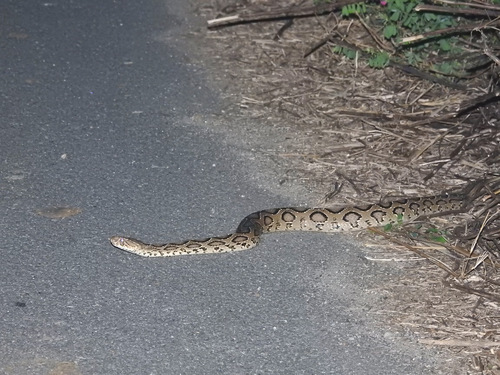
Possibly the worst snake on Earth, not for raw venom potency, but for deaths, life-changing injuries, and overall bite statistics. Russell’s vipers inhabit virtually of India, and are an ambush snake that preys on rodents and Indian palm squirrels. Symptoms include redness and blistering after 10 minutes, and plummeting blood pressure after 20 minutes.
The real danger of Russell’s vipers is their tendency to lurk on farmland, and this makes them exceedingly easy to step on. Farmers busying themselves with rice harvesting may fail to notice the Russell’s viper lurking in the brush. Russell’s vipers have excellent camouflage, with beige-black shades and no neon colours. Farmers are well aware that their fields are full of killer snakes, but they have a job to do and can’t complain. Insecticides may exist, but serpenticides currently don’t. Only recently have Indian farmers begun wearing thick protective boots en masse, despite it sounding like a simple idea.
There’s a saving grace though. In 2019, scientists implanted radio chips into 18 Russell’s vipers and tracked their progress through the countryside. The snakes often dozed just feet from farmers without attacking. Being stepped on caused an eruption of rage, but a few didn’t react even when stepped on. Somehow, they didn’t feel enough pain to activate their aggressive instincts. This snake is very lazy, and if you get lucky, the one you accidentally step on might be severely lazy.
| 6 | Brown house snake |
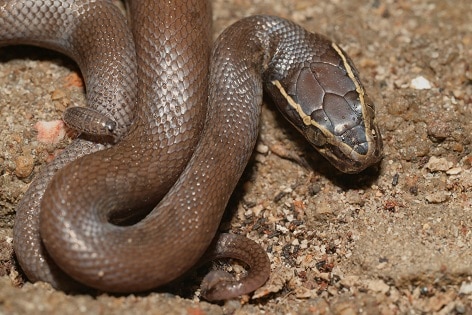
A harmless, common snake of southern Africa. Territories include South Africa, Zimbabwe, Botswana and Swaziland. Brown house snakes are one of the luckiest snakes around. They’re naturally flexible with a diet include black-necked agamas, house sparrows and South African hedgehogs alike. When humans converted the untouched African wild into a mosaic of villages, farmland and tree clumps, the brown house snake adapted well, while other snakes disappeared. It’s common in gardens, streets and courtyards, particularly under piles of rubbish.
But all this comes with a downside – a tendency to get stepped on. Brown house snakes lurk so close to dwellings that people don’t notice them and squash them under a heavy boot. They’re not the easiest snake to notice, with dull brown tones and no patterns, which are great for staying hidden, but not great for avoiding a footprint on their back.
Brown house snakes are relatively slow, unable to flee rapidly like the neighbouring rhombic staapsteker. Fortunately, there are no consequences to stepping on one, other than crushing guilt which haunts you forever (maybe their ghost will haunt you too). Brown house snakes are completely harmless, with no venom, or especially sharp fangs.
| 7 | Central American lyre snake |
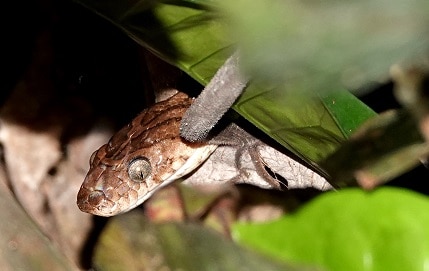
This snake is easy to step on because of its love for human environments. Central American lyre snakes are most common in western Nicaragua and northeast Honduras. They measure up to 180cm, and have a mild venom with haemorrhagins and myotoxins, which target blood vessels and muscle tissue respectively.
Trimorphodon quadruplex is common in gardens, lurking under tiles, piles of cuttings and patio furniture. They also break into houses and hide in dark corners, below TVs even. It’s possible for a Nicaraguan to wake up and start preparing breakfast, half asleep, before stepping on a random serpent on the floor. Likewise when they leave the front door half an hour later, and almost step on the original snake’s girlfriend. Central American lyre snakes are further disguised by their viper-mimicking patterns, which are complex blotches of beige and black.
This is a tricky snake which could be anywhere in a small Nicaraguan town. If stepped on, a Trimorphodon quadruplex may flee rapidly, or sink its fangs into your ankle. If so, you’ll be fine if you detach their mouth instantly. This is a rear-fanged snake which must chew over many seconds, or even minutes, to actually inject dangerous quantities of venom.
| 8 | Plainbelly watersnake |
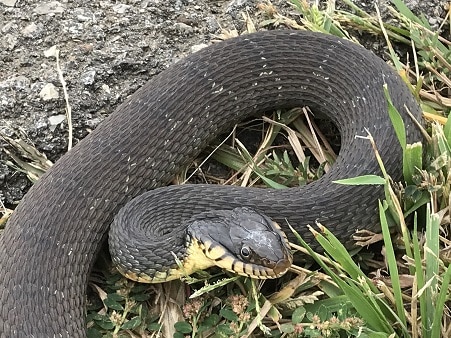
This species is easy to step on because among the 10 US watersnakes, they spend the most time on land. Plainbelly watersnakes (Nerodia erythrogaster) measure 75-120cm and range from Texas to Ohio. They’re recognisable by a bright yellow belly, which has no patterns.
In 2003, a study found that plainbelly watersnakes were far more adventurous than northern watersnakes. They regularly moved to upland areas, and could shift between over a dozen water bodies over one active season, travelling nonstop. Northern watersnakes preferred to stay in their main river base. Plainbelly watersnakes have a particular love for small pools in forests, which they spend just a couple of days in apiece, before impatiently moving on.
All this means that the risk of stepping on a plainbelly watersnake is far higher. They’re always on the move, whether in forests, grassy fields or riverside vegetation. They’re common in the exact places that dog walkers, fishermen and teenagers regularly walk through. You might spot the plainbelly watersnake below your boot, but be too late to arrest the momentum. Only their belly is brightly coloured; their back is a dull brown which easily blends with the earthy forest floor.
| 9 | Carpet python |
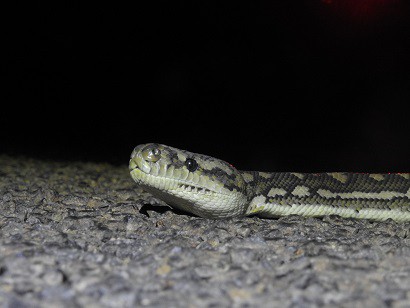
The carpet python is a thick Australian constrictor which is comfortable in urban streets, including in Sydney. Its favourite ambush sites are long, overgrown grass and dry brush. Its patterns are subtle beige rather than neon orange. This makes them a prime candidate for average Australians to accidentally step on.
You can meet a carpet python on your way to work, school or the grocery store. Carpet pythons can easily hang out behind your local bus stop, for example. They could be there in the undergrowth for weeks without anyone noticing. All it takes is for someone to sneak around for a quick cigarette to accidentally put their foot on a serpent. Carpet pythons even stash themselves in the steel beams of warehouse roofs. Any avid gardener in Sydney has a high chance of stepping on this thick constrictor.
What next? You’ll live, but you may collapse in shock as a carpet python deploys its sharp fangs against your leg. Being so large (3-4 metres) makes it easier to step on this species, not less. If they rested in open spaces then the opposite would be true.
| 10 | Four-lined snake |
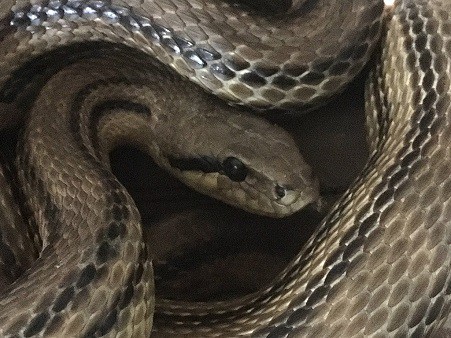
A patient, deliberate snake of Italy, which mainly preys on mammals like woodmice, but is also adept at slithering up tree trunks and pinching bird eggs from nests. Despite this, four-lined snakes prefer open areas with plenty of vegetation: clearings adjacent to forests, brambled slopes, bushy fields, and vegetation bordering agricultural fields. It’s these preferences which make them easy to step on. They’re hard to notice when slithering through long grass, and they also like roadside areas, maybe somewhere you’d stop for a desperate toilet break.
Four-lined snakes are one of Italy’s largest, at an maximum of 2 metres and a norm of 1.5-1.8m. There’s plenty of room for your foot to land.
Four-lined snakes rarely flee at high speeds either. When spooked, their default is to stay completely still, letting their subtle camouflage do all the work, even if the sky darkens and a boot is about to hit their head. Exploring kids could also step on four-lined snakes, as they have a particular liking for old stone ruins, whether a crumbling house foundation, or even an ancient Roman temple.
